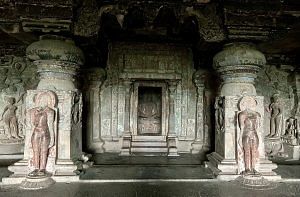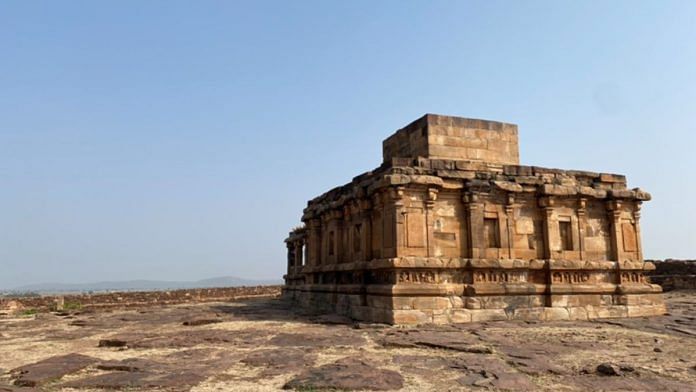A Kannada-speaking king died in 975 CE, after starving himself for three days at his guru’s monastery. His name was Marasimha II, and his kingdom was based near present-day Bengaluru. Marasimha, according to his court poet, had spent his life in war: he had participated in campaigns in Madhya Pradesh, slaughtered rival families, and even piled up the skulls of his enemies. Yet, in the last year of his life, he had erected Jain temples, and his ritual suicide was in a Jain monastery. Marasimha’s kingdom disappeared within a few decades of his death, but Deccan Jainism retained its following for almost 500 more years. This is one part of its story.
Why did Jainism spread?
By the time of Marasimha’s death, Deccan Jainism was already a grand old religion, counting among its adherents the plateau’s most powerful rulers, ascetics and litterateurs.
Historian RN Nandi writes in Religious Institutions and Cults in the Deccan that Jain monks began to appear in inscriptions from the 4th–5th centuries CE. Also around this time, other practices from North India, including permanent stone temples to gods and the use of Sanskrit in political settings, appeared in the Deccan. All these offered potent symbolic and political tools to newly emerging kingdoms, such as the Kadambas in present-day Banavasi and the Early Western Chalukyas in present-day Badami.
Deccan Jainism was woven into medieval South Indian kingship from the outset. In Bahubali and Bādāmi Calukyas, Jainism scholar Hampa Nagarajaiah notes that one of the earliest freestanding examples of Deccan architecture is Jain: it’s a temple on the Meguti hill at Aihole, built in the 7th century by Ravikirti, a Jain courtier of the Chalukya king Pulakeshin II (610–642 CE). The temple’s dedicatory inscription was composed by Ravikirti in Sanskrit. It shows that he was familiar with the political aesthetic of the Sanskrit cosmopolis—the sprawling medieval geocultural world that connected Sanskrit-speaking courts from Vietnam to Afghanistan.
The Meguti hill, where Ravikirti built his temple, was the most prominent part of Aihole town, and had been a sacred site from the Iron Age centuries prior (you can still see megalithic graves on the hill, outside Ravikirti’s compound.) This suggests that Aihole’s 7th-century Jain community was powerful and well-connected. Inscriptions from across Karnataka show that Jain orders migrated there from Varanasi, Bengal, and Gujarat. Just like Vedic Brahmins, Jains’ interpolity connections must have been very useful to kings.
Deccan Jains were aware of the contradiction between their non-violent principles and the martial political systems that granted them patronage. As such, they spilt much ink in exploring the ambiguities of power, and the duties of the ruler. Let’s look at one of these texts, the Adipurana of the Digambara monk Jinasena, studied by historian Paul Dundas in his chapter ‘The Digambara Jain Warrior’, part of the edited volume The Assembly of Listeners: Jains in Society.
The Adipurana was a mytho-historical text about Rishabha, the first Jain tirthankara, and the succession struggle between his sons Bharata and Bahubali. Bharata is depicted as the first world conqueror, overcoming his enemies; yet this is often shown to be inferior to his father’s overcoming of spiritual obstacles, such as passion and greed. Consumed by his hunger to rule, Bharata challenges Bahubali to a duel, but cheats. Bahubali still wins, but at the moment of his victory, he realises the transience of kingship and becomes a renunciant. Sobered, Bharata returns to his court and lectures his warriors about the duties of kingship.
Warriors, according to Jinasena (through Bharata’s mouth), are descended from the spiritual conqueror, the tirthankara Rishabha. So they should set their minds solely on Jainism, the true path to liberation. The king must protect the devout—the Jain community, yes, but also his other subjects. He must not resist more powerful neighbours but surrender “because war is bad for the people”.
Jinasena also warns kings away from akṣara-mleccha, literally “letter barbarians”, by which he means Vedic Brahmins “who live off the Veda, delude people by reciting words of unrighteousness and take pride in their false scriptural knowledge, delighting in violence and meat-eating.” On the other hand, “Jain Brahmins”, who were excellent due to their good qualities rather than birth, were to be respected.
How much of this was polemic? It’s difficult to be sure, but clearly, Jain scholars saw Hindu Brahmins as rivals—while also borrowing some ideas of caste hierarchy and purity. Jinasena’s patron, the powerful Rashtrakuta emperor Amoghavarsha I (800–878 CE), must have been pleased with the idea that weaker kings should submit to the stronger. The Rashtrakuta court financed spectacular Jain cave temples at Ellora, which are still worth a visit today. And Jinasena’s narration of the Bahubali legend, as we’ll see in a future edition of Thinking Medieval, proved tremendously influential.

Also read: This is how Jains came to dominate Gujarat
The monk and the warrior
King Marasimha II, who died in 975 CE, was an ally and relation of the Rashtrakuta emperors. He was not the only medieval aristocrat to ritually starve himself after a career of war and violence: dozens of Deccan inscriptions attest that monks, laymen and laywomen performed Jain austerities before death. It appears that Jainism was genuinely held to offer liberation, and coexisted with other beliefs. Hero stones show that Deccan aristocrats also believed that valiant warriors were carried to heaven by apsara damsels.
Why, then, was Jain ritual suicide so popular? An answer comes from the Harivamsabhyudaya of Bandhuvarma (c. 1200), a Jain telling of the Mahabharata legend, studied by historian Shadakshari Settar in Pursuing Death: Philosophy and Practice of Voluntary Termination of Life.
Pandu, the father of the Pandavas, is described as a Jain initiate who decides to give up the world. Accompanied by his junior wife Madri, Pandu goes to a Jain temple, circumambulates it, and takes vows. Senior teachers are assigned to supervise his food intake and see to his religious instruction. Then, he begins to quite literally battle with the senses and passions in preparation for death: “Like the knight decorated with the headband giving invitation [to his enemy], he meditates on the futility of samsara (the material world). Like the hero piercing and bleeding his enemy, he sheds the blood of inauspicious karma with the sharp tip of auspicious concentration.”
Settar also notes that before ritual starvation, Jain initiates were asked to confess their sins and absolve themselves. In the warlike world of the medieval Deccan, we should not underestimate the spiritual relief this may have offered, especially given that it was tailored to the warrior mind: the final renunciation was the greatest conquest.
Yet in this text, we see that the Deccan Jain community—while excoriating Brahmins—had many elements we think of as “Hindu”. It had temples and circumambulation; we know from inscriptions that Deccan Jain idols, like Deccan kings and Shiva lingas, received ritual ablutions. The adaptation of Mahabharata legends also indicates that Jains shared a common cultural substrate with their Brahmin rivals. Medieval religiosity must have been quite fluid: it may only have been religious leaders like Jinasena who saw their communities as exclusive, while most people picked up and patronised whichever traditions appealed to them.
Many paths offered liberation and peace to the dying. In Marasimha’s case, we’re also told, somewhat amusingly, that his suicide was a great relief to his enemies: “Aho! Chola king, quiet down by gently rubbing thy palpitating heart! O Pandya… give up weeping! O Pallava, run not away in fear… retreat not from thy territory, but remain! The Ganga chieftain… has gone in triumph to the abode of the gods!”
Anirudh Kanisetti is a public historian. He is the author of Lords of the Deccan, a new history of medieval South India, and hosts the Echoes of India and Yuddha podcasts. He tweets @AKanisetti. Views are personal.
This article is a part of the ‘Thinking Medieval‘ series that takes a deep dive into India’s medieval culture, politics, and history.
(Edited by Zoya Bhatti)




What is interesting about the narrative is how diverse thought processes of people, allow them to intermingle to make a social fabric, which exists even to this day.!!!!
Appreciate the information in the article but there is a mistake the author has made. Sallekhana cannot be termed as “ritual suicide”
Suicide is something done with a disturbed state of mind and is escapist. Sallekhana is the polar opposite, it is the giving up of the body, when it is no longer useful for penance and following the vows of Ahimsa in Jainism. It is carried out with a completely peaceful state of mind. It is the masterful art that only the most austere can perform, to equate it with suicide in any form is entirely a misrepresentation.
I please request the author to make this necessary change so as to be accurate with his words, as it can take on a different meaning otherwise.